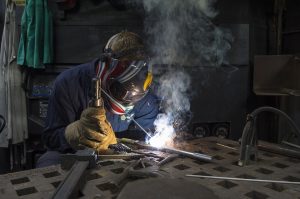
When researching some of the different welding processes, you may come across stud welding. It’s frequently used by manufacturing companies to install a fastener on a metal object or surface. Because of its similarities to flash welding, though, some people assume that stud welding is just another name for flash welding. Granted, both welding processes don’t require the use of a filler metal, but they aren’t necessarily the same. So, what is stud welding exactly?
Overview of Stud Welding
Stud welding is a welding process that involves the use of an electric arc to join a fastener to a metal object or surface. Whether it’s a rivet, bolt, nut or any other fastener — including threaded or unthreaded fasteners — is can probably be attached to a metal object or surface using stud welding. There are even special fasteners that are designed specifically for stud welding. Weld nuts, for example, have an elongated flange with excess metal that, when exposed to the heat of an electric arc, melt.
Benefits of Stud Welding
Stud welding is useful because it doesn’t require traditional methods to install a fastener on a metal object. Rather than drilling a bolt onto a metal object, for example, a manufacturing company can attach it using an electric arc. As the fastener heats up, some of the surface metal will metal. The fastener can then be manipulated into the right position, after which it’s allowed to cool. Once the fastener, as well as the metal object, cools, the fastener will join to the object.
The 2 Types of Stud Welding
Stud welding encompasses two principal methods: drawn arc and capacitor discharge. Drawn arc stud welding initiates an electric arc between the workpiece and the stud fastener, with the latter functioning as an electrode. This process, as documented, generates sufficient heat to melt both the stud and the designated area on the workpiece, facilitating their fusion. A critical aspect of drawn arc welding is the precise polarity required, necessitating direct-current electrode positive for aluminum and direct-current electrode negative for steel. Fundamentally, drawn arc welding invariably involves the heating of both the fastener and the substrate.
Conversely, capacitor discharge stud welding presents a distinct methodology that notably eliminates the necessity for flux. This absence of flux contributes to a more rapid and efficient welding operation, enabling manufacturing entities to execute this process with greater expediency compared to drawn arc welding. Empirical data indicates that capacitor discharge stud welding achieves an average weld cycle duration of a mere 1 to 6 milliseconds.
